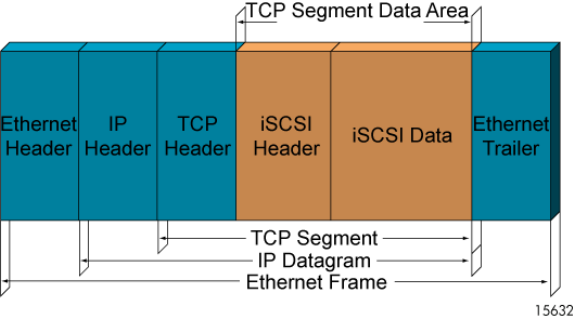HP StorageWorks 1510i Modular Smart Array iSCSI concepts and deployment guide (431338-002, July 2008)
Table Of Contents

iSCSI PDU overvi
ew
iSCSI initiators and targets communicate with messages known as iSCSI Protocol Data Units (PDU). An
iSCSI PDU has a header and an optional data section.
iSCSI PDUs are t
ransportedintheTCPsegmentdataareaofEthernetframes.ThesizeofaniSCSIPDUis
not dictated by
the capacity of the TCP segment data area and an iSCSI PDU does not need to begin at
aspecificoffse
t within a TCP segment data area. An iSCSI PDU can span multiple TCP segment data
areas or several iSCSI PDUs can be contained in a single TCP segment data area.
The following image illustrates the TCP segment data area of an Ethernet frame:
iSCSI layering overview
iSCSI constructs Protocol Data Units (PDUs) consisting of SCSI commands, SCSI data, and SCSI responses.
iSCSI PDUs are inserted in the TCP segment data area of IP datagrams. The IP datagrams are then
moved through the TCP/IP stack and transported over the network between the SCSI services layer of host
systems and the SCSI services layer of target storage devices. The iSCSI protocol works seamlessly over
TCP/IP networks without requiring any changes to TCP/IP protocols.
In the outbound direction (Initiator to Target):
1. The SCSI layer builds SCSI Command Descriptor Blocks (CDBs) and passes them to the iSCSI layer
(along with the rest of the command execution parameters).
2. The iSCSI layer builds iSCSI PDUs and relays them to one or more TCP connections.
3. The TCP connection(s) form an initiator-target “session” (I_T Nexus).
In the inbound direction (Target to Initiator):
1. The iSCSI layer receives iSCSI PDUs on one or more TCP connections in a TCP/IP stream.
2. The iSCSI layer extracts the SCSI CDBs from the iSCSI PDUs and passes them to the SCSI layer.
The following image illustrates iSCSI layering.
10 iSCSI overview










